Rainy season & washing

Rain, rain, rain. At this time of the year, it rains a lot in Japan.
This weather continues from early June through late July. We call this season "tsuyu"(pronounced like ts-you), often translated as "early-summer rainy season."
What bothers housewives most in tsuyu is, LAUNDERING. I'm sure every housewife (househusband?) in Japan will agree with it.
With the continuous rainy weather and high humidity of 70, 80, or 90 percent, laundry cannot dry fast, obviously!
Laundry driers sure have been prevailing recently, but it is not necessarily popular yet here.
I don't have one either. My reason is that it seems to be quite expensive to run; hanging up costs no electricity! Plus, I think I feel comfortable having laundry dried under the sun(, which disinfects the laundry with the ultraviolet rays!), rather than throwing it into a spinning hot cylinder worrying about the electricity bill.
Anyway, now laundering is the gloom and doom household chores for me.
But, OK, I'm gonna do today's share of washing. I have to.
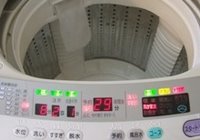
--- Turn the machine on,
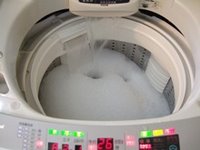
--- Pour water and detergent,
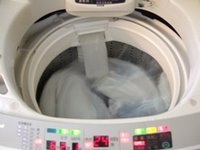
--- And wash.
Funny it is? Yes, this is my washing machine, which I have been used for eight years since getting married.
But I know this type of machine has been a bit old-fashioned here these years.
Recently washing machines in Japan has progressed a lot; many of them have the drum slanted off the horizontal, unlike mine with the vertical drum, in order to avoid users' back strain (so-called of universal design).
Increasing too is the "washer and drier combined" type of machines, and some even don't require detergent to make the laundry clean!! How surprising.
Japanese may be good at coming up with convenient but mysterious kind of mechanical devices... I'm afraid the machines might control us human beings sometime... could it be they already do?! :)
Higashi-Honganji
Today I visited Higashi-Honganji Temple, Kyoto. It locates north of Kyoto Tower, a few minutes' walk from there.
Higashi means "east."
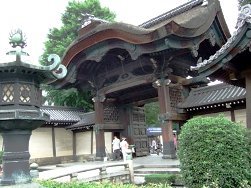 the Amidado-mon Gate
the Amidado-mon Gate

the Goeido-mon Gate
This gate is much larger than the previous one above, and actually it is, with the height of about 28 meters (31 yd.).
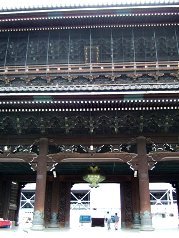 the front
the front

the elaborate carvings on a gate poll and door
 the Goeido-mon Gate on the left, and Goeido Hall on the right (the one with white walls: the hall in the walls is under construction).
the Goeido-mon Gate on the left, and Goeido Hall on the right (the one with white walls: the hall in the walls is under construction).
Between them, you can see Kyoto Tower! (it is in the south direction)
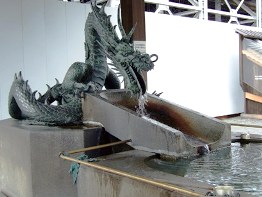
A dragon is spitting out water!
This is not just a fountain. Do you know what it is?
This kind of water tub is seen at almost all Japanese Shintoism shrines and Buddhist temples.
At the tub you are supposed to rinse your hands and mouth with the water, using a dipper there (in the photo you can see two on the edge of the tub), to get yourself "purified" and allowed to come up and pray at the shrine/temple hall.
 the Amidado Hall, where Amitabha is enshrined
the Amidado Hall, where Amitabha is enshrined
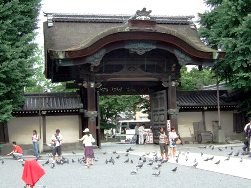
the back of the Amidado-mon Gate we saw above
Under the gate (in the almost middle of the photo), they are selling beans for doves, so there are a number of doves in the precincts!
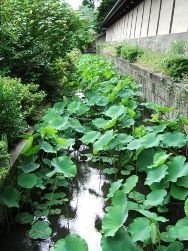
the lotus leaves in the moat around the temple, so vivid green
Since this is Higashi(
east)-Honganji, there must be
west Honganji, do you think?
Yes, you are right! There is Nishi(
west)-Honganji Temple, to the right west of this temple.
I will write about Nishi-Honganji someday... :)
Kyoto's temples and Tower
Yesterday at Kyoto City, two of my Japanese friends and me had a reunion with our friends from the U.S. who had arrived in Japan days ago. We haven't seen each other for years, so we had a very wonderful time doing sightseeing and chattering over a lot of things.
 This is the approach of Daitsu-in Temple, Kyoto. So beautiful, isn't it?
This is the approach of Daitsu-in Temple, Kyoto. So beautiful, isn't it?
It is a branch temple of Myoshinji Temple. Myoshinji has more than 40 branches in its precincts (so large!), and many of them have picturesque views like this too.
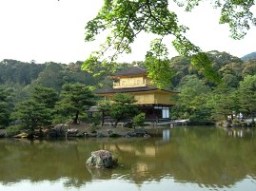 And again, the Golden Pavillion at Kinkakuji (formally Rokuonji) Temple. (I wrote about it on March 26)
And again, the Golden Pavillion at Kinkakuji (formally Rokuonji) Temple. (I wrote about it on March 26)
Literally, this pavillion is covered with gold leaf, therefore so shiny! Perfect spot for photo taking :)
The latest gilding was completed in 1987.
That is the story of yesterday. Today, after seeing the U.S. friends off, the left Japanese guys, me and my friend, went to Kyoto Tower.
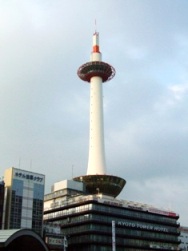 Kyoto Tower is just in front of Kyoto Station, you never miss it.
Kyoto Tower is just in front of Kyoto Station, you never miss it.
The tower itself is about 100 meters (111 yd.) high. Combined with the building beneath, 131 meters (145 yd.) high.

in the night, the tower looks like this:
(
These two tower photos are what I took the other days)
We went up the tower to the observation gallery.
The leaflet says the gallery locates at the level of 100 meters from the ground, but as arriving at the gallery, we felt it higher than we imagined; it gave us a full view of Kyoto City!

the city view in the southeast direction

the northeast direction
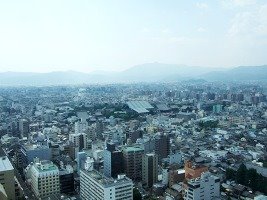 the northwest direction
the northwest direction
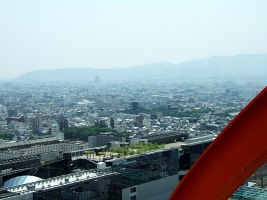 the southwest direction
the southwest direction
I realized more than ever that Kyoto is surrounded with mountains and a basin city!
MY tableware
Well, this idea has just occured to me; I think I will show you something unusual but might be interesting to you:

These are the Japanese-style tableware of my own that I actually use at my home everyday ;)
The right brown cup is "
o-wan," in which I put
miso(=fermented soybean paste) soup of my share.
O is an prefix to express politeness, and
wan means "cup."
Most o-wan's are made of wood and lacquered (like mine above), that is, japanware. The ones made of plastic covered with artificial lacquer are also popular.
The two sticks below the o-wan are my "
hashi (pronounced like
haa-she)," chopsticks. Japanese chopsticks used at meals are (artificial-) laquered wood ones. Mine above are 20cm (8 in.) long.
(You might have seen some joined chopsticks made of bamboo or thin bare wood. They are called "
waribashi," meaning "split chopsticks," that are split apart to be used. They are the disposable ones, used in restaurants or coming with sold box lunch)
The left white cup is "
cha-wan, " in which I put cooked rice of my share. Usually cha-wan's are ceramics(china) or pottery. (there are some plastic ones too)
Cha means "tea,"
wan means "cup," so cha-wan literally means " tea cup," but Japanese don't use cha-wan to have tea! Funny, huh? We use another kind of cups to have Japanese tea:
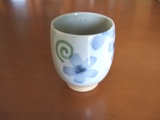

These 'tea cups' are called "
yunomi (pronounced like
you-know-me :) )" literally meaning "cup to have hot water with."
The left one is my own
yunomi I use everyday; the right one is what I prepare for my guest.
The common size of these tea cups is around 7-8cm(3 in.) in diameter. They are china or pottery.
As I often mentioned above, Japanese usually have
their own tableware at their home, o-wan, cha-wan, hashi and yunomi.
I have ever heard that this Japanese custom is surprising to people in Western countries. Is it true? Want to ask why Japanese have their own cups and chopsticks home? Well, I wonder why too! Contrary, why don't you have your own plates and knives& forks in your country if you don't?! :) :)
Now, how interesting the tableware difference is, isn't it?
You can buy those kinds of Japanese daily-use cups and chopsticks for several hundred yens (5-7 dollars) each. (high-class ones cost thirty, fourty or more dollars)
They are classified into men's, ladie's, kid's, and the size and design differ with each other; colors vary too.
When you visit Japan, why not try grabbing some for your own? ;)
























